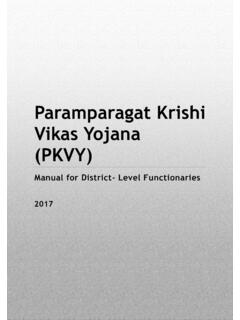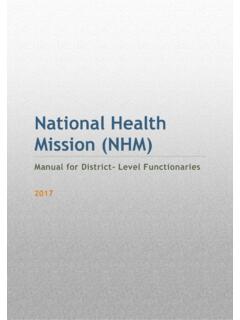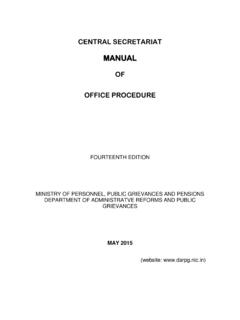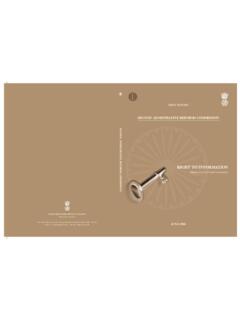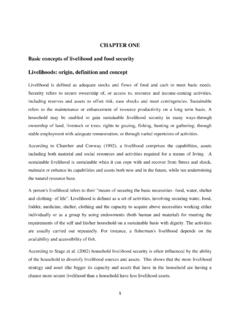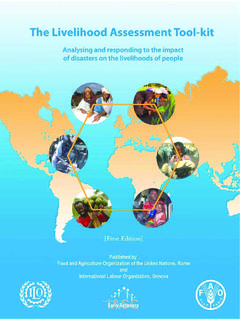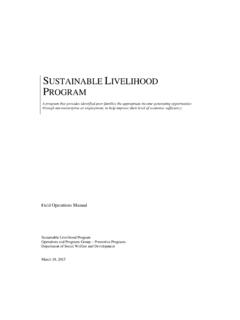Transcription of National Rural Livelihood Mission (NRLM)
1 National Rural Livelihood Mission (NRLM) Manual for District 2017 National Rural Livelihood Mission Manual for District - Level Functionaries Level Functionaries PREFACE The purpose of this Development Role Manual for National Rural Livelihood Mission (NRLM) is to create an enabling mechanism for improved implementation of the Centrally Sponsored Scheme (CSS) at the cutting edge, leading to enhanced outcomes in nature and extent. Accordingly, it would act as a guide for implementation by the District Collector and key District-level functionaries, enable quick learning, implementation modalities, roles and responsibilities of the various functionaries as well as stakeholders etc.
2 This Manual is prepared with inputs from a combination of sources, including interaction with the Ministry of Rural Development (MRD), Government of India (GoI), review of extant scheme guidelines and circulars issued by MRD from time to time and recently updated till August, 2017 and discussions with the key personnel involved in implementation of the Scheme. For greater direction, the guidelines cited must be referred to along with the NRLM website for guidance and clarification on implementation from time to time. Contents Table of Contents 1. National Rural Livelihood Mission (NRLM) .. 1 About the Scheme .. 1 Objective of the Scheme.
3 1 Key Features of the Scheme .. 1 Services and Beneficiaries .. 2 2. Administrative / Organisational Set up .. 3 National Level Functionaries .. 3 State Level Functionaries .. 4 District Level Functionaries .. 4 Block Level Functionaries .. 5 Institutional Structure .. 5 3. Coordination Mechanism .. 5 4. Funding Mechanism .. 6 5. Convergence .. 6 6. Roles and Responsibilities .. 7 Roles and responsibilities of District Level functionaries .. 7 Roles and responsibilities of Block Level functionaries ..10 Roles and responsibilities of Village level functionaries ..11 Role of Panchayat Raj Institutions (PRIs) ..12 7. Monitoring .. 12 Abbreviations .. 13 Endnotes and References.
4 14 List of Figures Figure 1 Organisational set up at National level Figure 2 Organisational set up at District level Figure 3 SHG Federations Figure 4 Involvement of PRIs vis- -vis SHGs List of Tables Table 1 Convergence issues and actions Table 2 Role of District Collector/District Magistrate Table 3 Role of District Rural Development Officer (DRDO)/Project Director, District Rural Development Agency (DRDA) Table 4 Role of Block Development Officer/Chief Executive Officer/Assistant Project Manager at the Block level Table 5 Role of Village level functionaries (Cluster Coordinator/ Community Organizer) and NGOs District Manual National Rural Livelihood Mission (NRLM) 1 1.
5 National Rural Livelihood Mission (NRLM) About the Scheme In spite of rapid growth of Gross Domestic Product (GDP) in India, a large Rural population of the country still lives below poverty line (BPL). Different studies estimated the rate of Rural poverty at different levels. In spite of the numerous efforts, the Rural poverty continues to be a major challenge to the Government at all levels. To address the challenge of Rural poverty, the Ministry of Rural Development conceived a Mission mode scheme titled as National Rural Livelihood Mission (NRLM) in the year 2010. NRLM was renamed as DAY-NRLM (Deendayal Antyodaya Yojana National Rural Livelihood Mission ) with effect from March 29, 2016.
6 It is a centrally sponsored scheme and the Central and State Governments jointly fund the projects. The implementation responsibility of the Mission is vested with State Rural Livelihood Missions (Special Purpose Vehicles). At the district level, a District Mission Management Unit (DMMU) is responsible for planning and implementation, but under the overall control of the district administration. At the block level, a Block Mission Management Unit implements the Mission activities. The Mission is implemented in a phased but intensive manner, taking up certain number of blocks in each year. The Mission is expected to saturate mobilization of all Rural poor households by 2023-24.
7 The Department of Rural Development in the Ministry of Rural Development, Government of India (GoI) has the overall responsibility of policy formulation, monitoring and evaluation of the programme and for release of funds. Objective of the Scheme The objective of the Mission is to promote sustainable livelihoods for the poor such that they come out of poverty. The institutions of the poor are intended to facilitate (i) access to formal credit; (ii) support for diversification and strengthening of livelihoods ; and (iii) access to entitlements and public services. Key Features of the Scheme Key features and components of the Scheme include: One member (preferably a woman) from each Rural poor household would be brought under the Self Help Group (SHG) network.
8 Women SHG groups would have bank-linkage arrangements. SHGs would be federated at village level and higher levels to provide space, voice and resources and to reduce dependence on external agencies. District Manual National Rural Livelihood Mission (NRLM) 2 The Mission consists four components, viz., (i) social mobilization, community institution and capacity building; (ii) financial inclusion; (iii) Livelihood promotion; and (iv) convergence. Participatory social assessment would be organised to identify and rank all households according to vulnerability. The ranking would be with reference to poorest of the poor, single woman and woman-headed households, disabled, landless, and migrant labour and they would receive special focus.
9 Training and capacity building of the poor, particularly in relation to managing the institutions, livelihoods , credit absorption and credit-worthiness. The Mission also supports development of skills for Rural youth and their placement, training and self-employment through Rural self-employment institutes (RSETIs), innovations, infrastructure creation and market support. Provision of Revolving Fund as a support to SHGs to strengthen their institutional and financial management capacity and build a good credit history. Provision of Community Investment Support Fund (CIF) in the intensive blocks to the SHGs through the Federations to advance loans and/or undertake common/collective socio-economic activities.
10 Introduction of financial inclusion model, loaning from banks, association and coordination with banking/financial institutions and coverage from loss of life, health etc. Provision of Interest Subvention on loans availed by SHGs to cover the difference between the lending rate of the banks and 7%. Convergence with various ministries and agencies dealing with poverty reduction of Rural poor. Highly decentralised planning; and States will have liberty in developing their own action plan for poverty reduction. NRLM to have suitable linkages at the district level with District Rural Development Agencies (DRDAs) and Panchayat Raj Institutions (PRIs). Services and Beneficiaries The beneficiaries under the scheme are Rural poor; and instead of providing direct financial support, the scheme envisages that the poor are organised into institutions and make them own the institutions, acquire sufficient capacity building and handholding support, access institutional credit and pursue livelihoods based on their resources, skills and preferences.


